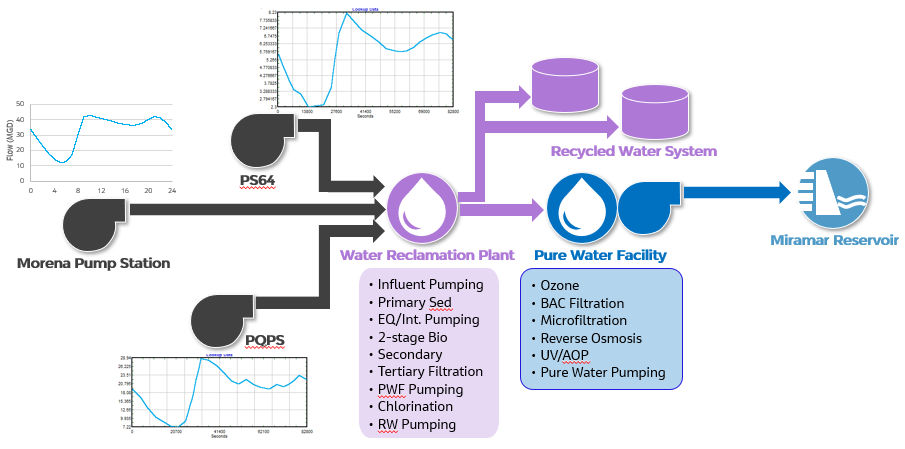Winning with Twinning – How digital twins reduce risk by improving system understanding
From 28 March to 2 April, the International Water Association (IWA) is hosting its 17th Leading Edge Conference on Water and Wastewater Technologies, otherwise known as LET2022. I will be talking about Pure Water San Diego’s Implementation of a Digital Twin to Improve System Understanding and Support Commissioning during the “Emerging Technologies for Digital Water” session.
The Pure Water San Diego Project
The City of San Diego is in the initial stages of implementing the Pure Water San Diego program, which when completed in 2035, will supply at least 40 percent of the City’s drinking water. Phase 1 of this program includes multiple facilities: (1) Morena Pump Station, (2) North City Water Reclamation Plant (WRP), (3) North City Pure Water Facility (PWF), (4) Miramar Reservoir, and (5) Miramar Water Treatment Plant and 11 different projects that will enable the City to treat and clean recycled water to produce 30 million gallons per day (MGD) of high-quality purified water. This state-of-the-art water resource will reduce San Diego’s dependence on imported water.
A schematic of the Pure Water system is shown below. For the Pure Water system to function as planned, all of the program elements must be coordinated through a complex and integrated control strategy. A digital twin was used in the design phase of the project to better understand how the full system will operate. My presentation introduces this unique application of a digital twin and highlights the value it provided to the Pure Water program.

Implementing the Digital Twin
A digital twin model was developed for both the North City Water Reclamation Plant (WRP) and the North City Pure Water Facility (PWF) and operates in the ExtendSIM™ modeling platform, which is an open-source dynamic simulation environment.
A library of hydraulic blocks was developed to accurately simulate water moving through both pressurized (pumps, pipes, valves) and gravity (channels, weirs, tanks) flow systems, allowing full treatment plants to be modeled. A separate library of controls blocks was developed to simulate typical treatment process control strategies, including function blocks and PID controllers. Together, these libraries allow for the system to be modeled as it will operate in the future and for various control strategies to be tested under a variety of scenarios. A typical model run simulates a 24-hour period in approximately 20 minutes of model time, allowing for evaluation and optimization of different operational strategies.
Our primary reason for developing a digital twin was to create an integrated control strategy for the Pure Water system. This is inherently challenging as the WRP influent flows follow a typical diurnal pattern (diurnal flow patterns at collection system pump stations are shown in Figure 1.1) but the PWF requires a constant flow for the reverse osmosis system to operate well. Primary effluent equalization was designed as part of the WRP upgrades to attenuate flows. The digital twin was used to develop a control strategy that accommodates a range of influent flow profiles and provides a consistent effluent flow.
The digital twin was also used to track water quality through the PWF and WRP system where it was relevant for process control. Notably, there is a total dissolved solids (TDS) limit for several of the non-potable water users and at times the PWF effluent, which has passed through reverse osmosis, will be blended with the WRP effluent to meet the TDS demands of these users. This, among other water quality criteria was included in the model to better understand the system performance under a range of operating scenarios.
Conclusion
Digital twins are becoming more common in the water sector as the industry struggles with increasingly complex systems and an aging operational workforce. With the increase in online analyzers at facilities, we now have an opportunity to better understand system operation through evaluation of historical data. With the development of digital twins, we have realistic simulations of future plant operation as well as calibration of existing facilities using the collected data. The application of digital twins provides meaningful value for complex systems. I look forward to sharing how this project demonstrates a unique application of digital twins that reduces risk by improving system understanding and the value it brought to the Pure Water project.
Find out more about the IWA LET conference: iwa-let.org

